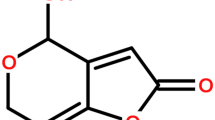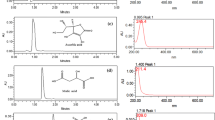Abstract
Despite the wide distribution of citrinin-producingPenicillium spp. there are only rare reports about the occurence of this mycotoxin in foodstuffs. Particularly, the discrepancy between the common detection of the applerotting fungusP expansum and the complete lack of data about the occurrence of citrinin in apple-based foods is noteworthy. Based on an indirect enzyme immunoassay (EIA) a study was performed aiming at the sensitive detection of citrinin in apple and other fruit juices. The direct analysis of diluted apple juices by the EIA failed due to pronounced sample matrix effects. Though these problems could be resolved by the extraction of artificially contaminated apple juice with dichloromethane, a poor recovery rate (20–30%) for citrinin was observed. Astonishingly, similar results (mean recovery of 29.9%) were received when doted apple juices were directly purified on immunoaffinity columns despite the minimal sample treatment associated with this method. For the detection of citrinin in tomatoe juices samples were purified with a liquid-liquid partition step. Again, the mean recovery rate was very low (32.0%). Analyzing 55 fruit and vegetable juices purchased in local retail stores only traces of citrinin (maximum 0.2 μg/L) could be detected in the samples.
Similar content being viewed by others
References
Abad A, Manclus JJ, Moreno MJ, Montoya A (2001) Determination of thiabendazole in fruit juices by a new monoclonal enzyme immunoassay. J. AOAC Int. 84: 156–161.
Abrunhosa L, Paterson RRM, Kozakiewicz Z, Lima N, Venancio A (2001) Mycotoxin production from fungi isolated from grapes. Lett. Appl. Microbiol. 32: 240–242
Dietrich R, Usleber E, Märtlbauer E, Gareis M (1999) Nachweis des nephrotoxischen Mykotoxins Citrinin in Lebensmitteln und mitMonascus spp. hergestellten Lebensmittelfarbstoffen. Arch. Lebensmittelhyg. 50: 17–21.
Frank HK (1992) Citrinin. Z. Ernährungswiss. 31: 164–177.
Harwig J, Kennedy BPC, Scott PM (1973) Occurence of patulin and patulin-producing strains ofPenicillium expansum in natural roots of apple in Canada. Can. Inst. Food Sci. Technol. J. 6: 22–25.
Scudamore KA, Nawaz S, Hetmanski MT (1998) Mycotoxins in ingredients of animal feeding stuffs: II. Determination of mycotoxins in maize and maize products. Food Addit. Contam. 15: 30–55.
Vrabcheva T, Usleber E, Dietrich R, Märtlbauer E (2000) Co-occurrence of ochratoxin A and citrinin in cereals from Bulgarian villages with a history of Balkan endemic nephropathy. J. Agric. Food Chem. 48: 2483–2488.
Author information
Authors and Affiliations
Rights and permissions
About this article
Cite this article
Dietrich, R., Schmid, A. & Märtlbauer, E. Citrinin in fruit juices. Mycotox Res 17 (Suppl 2), 156–159 (2001). https://doi.org/10.1007/BF03036426
Issue Date:
DOI: https://doi.org/10.1007/BF03036426




